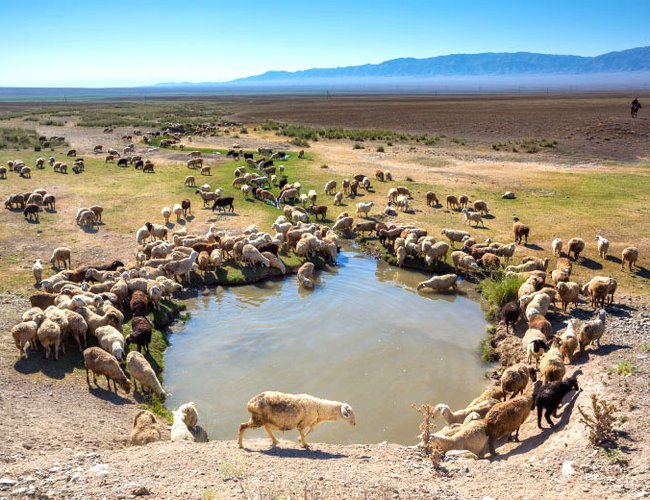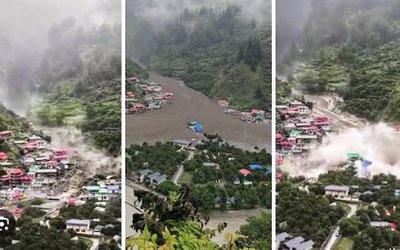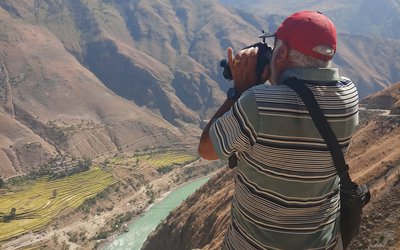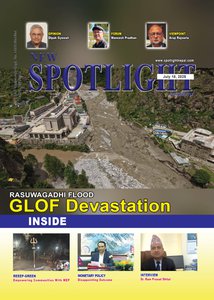
The Context of Climate Crisis in Central Asia
Central Asia is rapidly becoming a climate and disaster hotspot, with escalating risks that threaten both its socio-economic stability and its environmental future. According to UNEP (2024) and ICIMOD (2023), Central Asia has lost approximately 30% of its glacier surface area over the past five to six decades, leading to reduced river flows and intensifying the regional water crisis. World Bank projections (2023) indicate that by 2050, the Syr Darya and Amu Darya river basins could experience a 10–15% decline in water volume. In Uzbekistan, ADB (2024) reports that the current water deficit of 3 billion cubic meters is expected to increase to 7 billion cubic meters by 2030 and 15 billion cubic meters by 2050. Simultaneously, UNECE (2024) highlights that the Caspian Sea shoreline in Kazakhstan has retreated over 20 kilometers in two decades, severely impacting fisheries and biodiversity.
The region’s vulnerability is further underscored by the fact that over 150 major disasters have occurred in the past 30 years, affecting 11 million people and causing losses exceeding USD 4 billion (World Bank Group, 2024). Climate change-driven land degradation has added to the toll, leading to annual economic losses of about USD 6 billion (Mirzabaev et al., 2016). This environmental stress has pushed 10–15% of the economically active population to seek better livelihoods elsewhere (UNCCD, 2023). The rise in temperature—between 4.8°C and 6°C in Kyrgyzstan over the past two decades—is expected to reach 6°C region-wide by 2096, accelerating glacier melt, amplifying water scarcity, and increasing flood and landslide risks. Extreme weather events are becoming more frequent, with, for example, Kazakhstan and Uzbekistan seeing temperatures hit 44.6°C and 45.5°C respectively in June 2023. Seismic activity further compounds the situation, causing USD 2 billion in annual losses, while flooding costs the region between USD 1.5 billion and USD 2.2 billion each year (World Bank Group, 2023). Central Asia’s environmental crisis, fueled by climate risks, water scarcity, glacier melt, desertification, and extreme weather, is compounded by pollution and industrial emissions, threatening ecosystems, agriculture, and public health, highlighting the urgent need for integrated climate adaptation and disaster risk reduction.
Crisis Drivers in Central Asia: Mismanagement, Melting Glaciers, and Pollution
Water scarcity and mismanagement: Water scarcity and mismanagement, intensified by climate change, inefficient water use, and governance failures, have become critical challenges for Central Asia. The glacier mass in the Tien Shan Mountains declined a shocking 27% between 1961 and 2012. In total, 2,960 km² of ice were lost. Projections suggest that by the 2050s, half of this glacier volume could vanish, endangering essential freshwater supplies and increasing the risk of floods and landslides (Farinotti et al., 2015). Meanwhile, prolonged droughts in Turkmenistan’s Karakum Desert have caused up to 40% of crops to fail, and, in Uzbekistan, wasteful irrigation practices squander up to 60% of diverted water and have contributed to the catastrophic shrinkage of the Aral Sea (Adaptation Fund, 2020). Fragmented cooperation over shared rivers like the Amu Darya and the Syr Darya has only worsened water management efforts. The consequences have been dire. Over-extraction from the Amu Darya and the Syr Darya rivers has drained the Aral Sea, transforming it into the Aralkum Desert, devastating the fishing industry and leaving entire communities unemployed. The exposed seabed releases toxic dust laden with pesticides and fertilizers, driving a surge in respiratory illnesses. Meanwhile, the Caspian Sea has experienced a significant decline in water levels, with estimates suggesting a decrease of 7 cm annually starting in 1996, totaling a loss of approximately 1.5 meters by 2015 (ERI, 2020). Projections indicate that by the end of the 21st century, the water level could fall by 9 to 18 meters, potentially reducing the sea's surface area by 23% to 34% (Kaleji, 2023). This decline threatens the Caspian's biodiversity, causing habitat loss for aquatic species and disrupting local fisheries, worsening the region's environmental challenges.
Desertification and land degradation: Desertification and land degradation are urgent crises in Central Asia. Both are driven by climate change, unsustainable land management, and escalating disaster risks. According to FAO (2024) and UNCCD (2024), approximately 27.1 million hectares of pastureland in Kazakhstan—around 15% of the national territory—are severely degraded, primarily due to overgrazing and deforestation. ICIMOD (2023) and UNEP (2024) project that by the 2050s, up to 50% of the glacier volume in the Tien Shan Mountains could disappear, threatening critical freshwater supplies and increasing the risks of floods and landslides. Research by the University of Zurich (2023) indicates that since the 1960s, glaciers in the Tien Shan have lost 27% of their mass and 18% of their area, with an average annual loss of 5.4 gigatons of ice. It further estimates that about half of the current glacier volume could be depleted by the 2050s (Farinotti et al., 2015). According to data from the European Space Agency (2025), the shrinking of the Aral Sea has given rise to the Aralkum Desert, which now spans 38,000 square kilometers. The expanding Aralkum Desert, fueled by the Aral Sea's depletion, generates toxic dust storms carrying pesticides and fertilizers which worsen respiratory illnesses. Desertification has ravaged agriculture and triggered rural migration, while weak policy enforcement and limited regional cooperation hinder land restoration, highlighting the need for coordinated solutions in Central Asia.
Glacier melting and reduced snowpack: Glacier melt and the decline of snow packs are rapidly reshaping Central Asia’s landscapes, threatening both ecosystems and livelihoods. The glaciers in Kyrgyzstan's Tien Shan range, particularly in the Naryn region, have experienced significant shrinkage from 1965 to 2010, primarily due to rising temperatures and declining precipitation. Detailed studies report glacier area reductions ranging from 14% to 42% across different mountain ranges within the Naryn basin (Azisov, E., Hagg, W., & Kääb, A., 2012). The Hindu Kush Himalayan region faces similar challenges, with glacier retreat accelerating and unstable glacial lakes emerging. Black carbon from biomass and fossil fuel burning accelerates ice melt in the Himalayas, worsening water scarcity and flood risks for communities dependent on glacial melt water. In Kyrgyzstan, the loss of glaciers disrupts ecosystems, escalates risks of energy shortages, and heightens the likelihood of climate-induced disasters. A vivid example is Lake Merzbacher, where annual ice dam failures result in catastrophic floods, wreaking havoc on infrastructure and livelihoods downstream.
Extreme weather events: Central Asia is facing an intensifying pattern of extreme weather events, driven by rising temperatures, shifting rainfall, and changing atmospheric conditions. Over the past two decades, Kyrgyzstan's average annual temperature has risen by approximately 1.3°C, with some regions experiencing increases of up to 6.1°C (IMF, 2023). These increases have resulted in more frequent heat waves and altered rainfall patterns. Recent studies indicate that the weakening of the Siberian High has disrupted winter climates in Central Asia, leading to warmer winters and unpredictable precipitation patterns. These shifts have caused droughts and heavy rainfall, straining agriculture, water systems, and infrastructure, while threatening food security, energy, and public health.
Pollution and industrial emissions: Pollution and industrial emissions are pressing challenges in Central Asia. They are exacerbated by rapid industrialization, weak environmental regulations, and climate change impacts. In Uzbekistan, the legacy of Soviet-era cotton farming policies led to the diversion of the Amu Darya and the Syr Darya rivers, causing the Aral Sea to shrink catastrophically. This shrinkage exposed toxic lakebed sediments containing pesticides and fertilizers. These contaminants are carried by winds, worsening air pollution and raising health risks for nearby communities. According to UNEP (2024) and the World Bank (2023), the Caspian Sea’s water level in Kazakhstan is declining by approximately 25 cm annually, driven by reduced river inflows. This trend has severely impacted the fishing industry, increased pollutant concentrations, and caused significant biodiversity loss. These crises highlight the urgent need for effective environmental management and strong regulations to protect ecosystems and public health.
Central Asia’s Collective Action on Climate and Environmental Challenges
In response to the challenges discussed in the earlier section, Central Asian countries have launched collective actions to tackle water scarcity and improve resource management, with support from international organizations. The International Fund for Saving the Aral Sea (IFAS) leads the Aral Sea Basin Programs (ASBPs), which focus on restoring ecosystems, improving water governance, and promoting sustainable agriculture. The Third ASBP mobilized over USD 15 billion in regional projects, and the ongoing Fourth ASBP (2021–2030) is committed to integrated water management and environmental recovery. Key initiatives include implementing drip irrigation in Uzbekistan's cotton fields to reduce water waste by 40% and rehabilitating Kyrgyzstan’s water storage systems to better manage glacier melt. IFAS also helped ease tensions over sharing water among Kyrgyzstan, Tajikistan, and Uzbekistan, promoting regional collaboration. In Turkmenistan, the adoption of climate-resilient farming practices, backed by the World Bank and UNDP, offers a hopeful path toward securing the region’s water future. The World Bank-supported Central Asia Water and Energy Program (2009) addresses climate change, water scarcity, and land degradation through regional cooperation, while Kazakhstan works on Caspian Sea restoration, and Kyrgyzstan, Tajikistan, Turkmenistan, and Uzbekistan focus on water management, glacier retreat, and sustainable land practices to reduce water scarcity and mismanagement. UNDP's regional initiative, called ‘Enhancing Urban Resilience to Disaster Risk and Climate Change in Central Asia’ aims to bolster climate resilience in urban areas through climate and disaster risk assessments, with support from the Government of Japan.
To reverse desertification and land degradation, Central Asian countries have launched various initiatives with strong support from regional cooperation and international partners. The IFAS plays a pivotal role in directing resources through the ASBP, focusing on landscape restoration and sustainable agriculture. The First ASBP (1994–1997) mobilized USD 60.8 million for environmental stabilization, while the Global Environment Facility (GEF) has contributed over USD 22 billion to land restoration efforts across the region. These initiatives have fostered practical actions such as soil management in Turkmenistan to prevent salinization, large-scale ecological restoration to curb the spread of the Aralkum Desert in Uzbekistan, and reforestation efforts to rehabilitate Kazakhstan’s pasturelands. Central Asian countries, which have committed themselves to the UN Convention to Combat Desertification since the mid-1990s, have developed national action plans and set land degradation neutrality targets. The Green Central Asia II initiative, launched in 2021, fosters regional cooperation on climate-sensitive water, land, and climate risk management. It supports policy dialogue and projects, guided by a Regional Joint Action Plan. UNDP helps Central Asian countries tackle desertification and land degradation by promoting sustainable land management, policy action, and regional collaboration. National policies focus on combating desertification through sustainable agriculture, pasture rehabilitation, soil conservation, and addressing the Aral Sea crisis with water management and land reclamation efforts.
In response to glacier retreat and disappearing snow packs, Central Asian countries, especially Kyrgyzstan, are taking proactive mitigative steps. With support from the IFAS, Kyrgyzstan has prioritized integrated water resource management, climate-resilient agriculture, and ecosystem restoration under the ASBP. These efforts aim to safeguard water resources, enhance food security, and sustain hydropower production despite the shrinkage of glaciers in the Tien Shan Mountains. UNDP supports Central Asia’s response to glacier retreat and snowpack loss through enhanced climate resilience, water management, and regional adaptation efforts. Furthermore, the UNEP, in collaboration with the Asia Pacific Adaptation Network, is bolstering the capacity of local communities to manage the risks associated with glacial lake outburst floods and other climate-related threats. These initiatives reflect the region’s commitment to building resilience and creating a sustainable future in which both communities and ecosystems can thrive. The ADB-supported Glaciers to Farms Program (2024) promotes sustainable water use and food security in Central Asia, while UNDP initiatives focus on monitoring glaciers and permafrost to address climate impacts. Kyrgyzstan, Tajikistan, and Uzbekistan are implementing national policies to monitor glaciers, improve disaster risk management, and enhance water resource planning.
In response to the growing impacts of extreme weather, particularly the winter energy crisis in Tajikistan, Central Asian countries have launched a series of coordinated and innovative initiatives, supported by UN agencies, international partners, and the private sector. UNDP helps Central Asia tackle extreme weather and winter energy crises by advancing resilient energy systems, disaster readiness, and sustainable infrastructure. In the short term, Tajikistan has focused on rehabilitating hydropower infrastructures and adopting energy-efficient technologies to ensure it has a stable supply of electricity. Long-term strategies emphasize regional cooperation in managing water and energy resources, striking a balance between hydropower production and agricultural needs. Community-based adaptation efforts, such as promoting energy-efficient housing and drought-resistant crops, aim to protect vulnerable populations. The private sector has also played a crucial role by investing in renewable energy sources such as small-scale hydropower and solar systems, diversifying the region’s energy mix. Together, these efforts are building the foundation for a more resilient, sustainable future for both the people and the ecosystems. Central Asian countries are collaborating on regional strategies like the Climate Change Adaptation and Sand and Dust Storms Management Strategies (2021-2030) to address extreme weather events. Initiatives such as the Climate and Environment Program (2024) and the High-Level Central Asian Dialogue (2022) enhance climate resilience and sustainable development. National climate strategies focus on mitigation and adaptation and are bolstered by regional cooperation designed to strengthen resilience and adaptive capacity.
Central Asian countries have initiated a range of measures to mitigate environmental and public health challenges. In Uzbekistan, efforts to counter the effects of the Aral Sea’s desiccation have included providing medical aid, cleaning up contaminated areas, and implementing water-saving irrigation systems and sustainable farming practices. Long-term strategies, such as the UN’s ASBP, focus on promoting transboundary cooperation, reducing pollution, and fostering sustainable land use. UNDP supports Central Asia in addressing environmental and health challenges through policy integration, capacity building, and sustainable development efforts. Research institutions are playing a vital role in shaping policies to combat industrial emissions, while CSOs and NGOs continue to advocate for stricter environmental regulations and greater accountability. In Kazakhstan, the private sector has been an active participant which investing in cleaner technologies and renewable energy solutions. Together, these efforts are helping to reduce pollution, improve public health, and promote a more sustainable future across Central Asia. The UNECE Convention (1979) on Long-range Transboundary Air Pollution, the Gothenburg Protocol (1999), and regional air quality initiatives focus on reducing air pollution through cooperative strategies, emission targets, and strong legal frameworks across Europe and Central Asia. Kazakhstan is transitioning thermal power stations to natural gas, while Uzbekistan is investing USD 1.3 billion in waste-to-energy projects to convert solid waste into electricity.
From Risk to Readiness: Urgent Calls for Resilience
The cascading environmental challenges unfolding across the region reveal an urgent and undeniable truth: sustainable water and land management can no longer wait. Unsustainable farming practices, shrinking glaciers, intensifying droughts, and increasing climate extremes are reshaping ecosystems and livelihoods. These shifts, all of which are accelerated by climate change, demand immediate action to adopt climate-smart agriculture, modern irrigation techniques, and robust environmental safeguards. They also expose the fragility of vital services, from water supply to energy and disaster response, emphasizing the need for resilient infrastructure and energy security. As the region faces mounting risks, regional cooperation and integrated planning are essential to protect people, ecosystems, and economies. Guided by clear protocols and clearly defined roles, governments must forge strong alliances with the private sector, civil society, and academia to co-create a unified roadmap for sustainable development. Equally essential is robust knowledge management: policies and programs must be shaped by empirical evidence, continual learning, and real-time evaluation. Ground-level insights should inform agile policy reforms and enforcement mechanisms, ensuring that decisions are both responsive and relevant. To scale impact, strong partnerships with development agencies and national governments are vital. These will mobilize technical expertise and financial resources where they are needed most. Regional initiatives must be up-scaled and adapted based on documented successes, ensuring that proven solutions drive broad transformation. Together, these efforts will enable Central Asia to protect its natural heritage, strengthen climate resilience, and secure a more stable, prosperous future for generations to come. Driving meaningful change in Central Asia demands bold, forward-looking strategies rooted in inclusive collaboration and grounded realities.
Dr. Dhruba Gautam is an Independent Evaluator and Consultant with extensive expertise in energy, natural resource management, climate resilience, disaster risk reduction, and sustainable livelihoods across the Asia-Pacific and Caribbean regions. His insights in this article are grounded in decades of strategic and field-based evaluations of natural resource management (NRM) initiatives in diverse Central Asian contexts. For collaboration or inquiries, he can be reached at drrgautam@gmail.com.
- Beyond The Storm-Women, Climate, And The Power of Inclusion: Unlocking Stronger Climate Strategies through Gender-Responsive Action in the Pacific and Caribbean
- May 27, 2025
- Battling Tides, Rising Waters, And Shifting Shores: Polynesia’s Determined Advance Toward Climate Resilience
- May 19, 2025
- Sustaining Nature; Sustaining Culture: The Anthropology Of Resource Management In The Pacific And Caribbean
- May 09, 2025
- Buried Dangers, Lasting Impact: How Landmines Erode Peace, Stifle Recovery, And Endanger Communities' Wellbeing
- May 04, 2025
- East Asia’s Environmental Evolution: Transforming Climate Challenges Into Drivers Of Ecological Progress And A Resilient Future
- May 02, 2025














